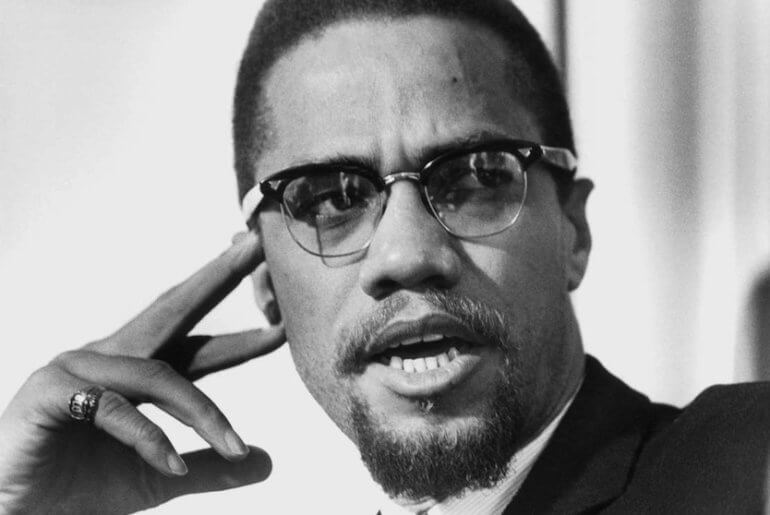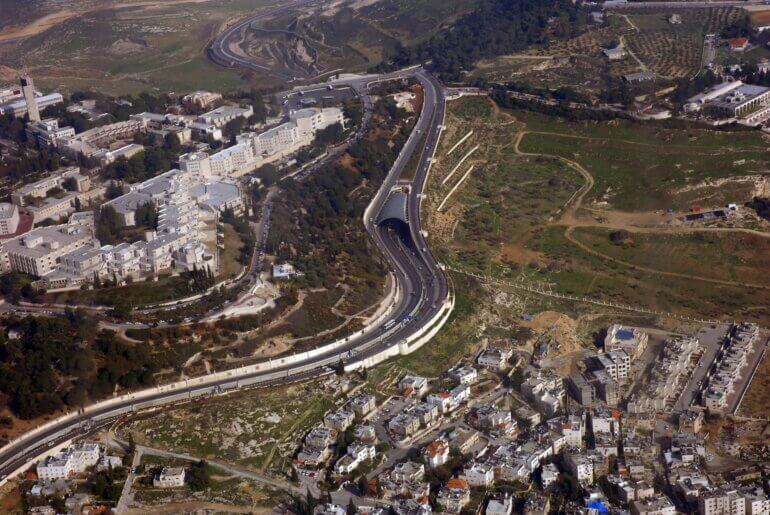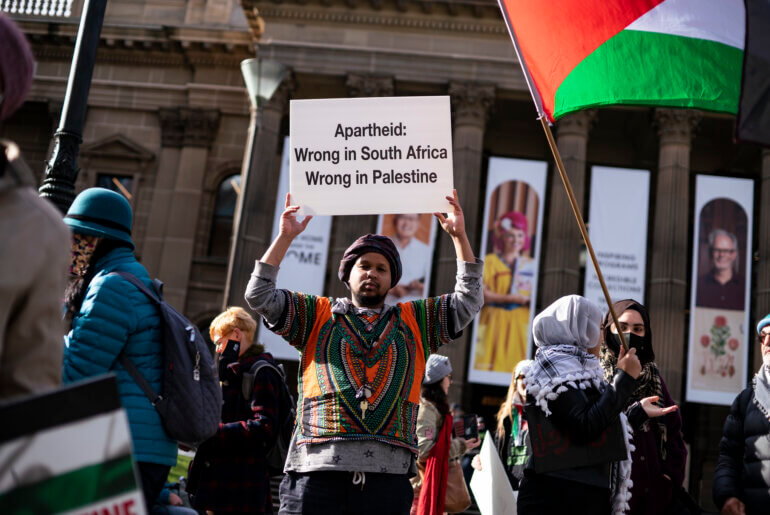At the beginning of the second Intifada in 2000, vast anti-occupation protests were held throughout Palestine and Israel. 62 Palestinians were killed by Israeli forces during the first 10 days of the demonstrations, including a 17-year-old peace activist named Asel Asleh.
Playwright Jen Marlowe was a friend of Asel and began collaborating on a project with his sister after his death. Marlowe’s interviews with his sister, and other members of his family, ended up inspiring Marlowe’s There is a Field, which has now been performed throughout multiple countries for years.
A few years ago, Donkeysaddle Projects (an organization that Marlowe founded) began partnering with Black Lives Matter organizations to hold theater-based community residencies that use the play as a framework to promote Black-Palestinian solidarity. In 2018, a number of former residency participants traveled to to Peñasco, New Mexico to film a performance of the play and talk about building connections across various struggles. Marlowe’s new documentary (also titled There is a Field) showcases this experience. She spoke with Mondoweiss’ Michael Arria about the film.
This project is very personal for you. Can you describe how you came to write the play?
Jen Marlowe: Asel was murdered on October 2nd 2000 and he was a friend of mine. I felt his murder very personally and deeply. At the time, I had no idea what the project would evolve into and what this work would evolve into, but what felt very clear to me was that I wanted to do everything I could to make sure that the story was told and that his family’s struggle was told.
The idea of it being a play came out of working in theater–this was before I started working in documentary film and the other media that I eventually started to work in. So at the time, the idea of writing a play felt like a natural way to try to ensure that Asel’s story would be told, the injustice that happened to him and his family would be exposed. I don’t know exactly why the idea of it being a documentary play felt so clear to me, but I did feel that it needed to be based on people’s real words, both Asel’s own in the writings that he left behind, as well as his family members, particularly his older sister. I just instinctively felt that this was an important way to tell the story– through the actual real words of the people most directly impacted by his murder.
You revisit the script years later and start to see parallels with the play and what’s happening in the United States at the time. Can you talk about that process?
2010 was the first iteration of performing the play and it was an earlier version of the script. 2010 was the ten-year commemoration of Asel’s murder and the beginning of the Second Intifada, so we launched the script as a global theatrical action with a call to folks all over the world to use the script in some way to mark the anniversary.
There were over forty different performances and readings of the play all over the world throughout October 2010, and then I put the script away and didn’t really look at it again for years. It was the summer of 2014 that I picked it back up and started diving back into it. We were organizing a tour that was going to happen in 2016 and this was in preparation for that.
2014 was, of course, when the Ferguson uprising was happening. It was the summer that Michael Brown was killed and before Michael Brown, Eric Garner had been murdered. It was an early moment in what became a resurgence of the movement for black lives. That summer I was watching the news and seeing the response to the police murder of an unarmed teenager, and then I was going and working on the script and seeing so many of those same things. I was seeing so many parallels between the injustices that Michael Brown’s family were facing and the injustices that Asel’s family were facing. Related not just to the issue of police brutality, but also related to the issues of impunity and structural racism.
At what point did you realize you wanted to make this film and how did your timetable line up with what’s currently happening in the country? Did you feel a renewed sense of urgency with the project after the protests over George Floyd’s murder?
Our overarching goal for this film is for it to play a useful role in connecting struggles and in connecting movements.
We filmed this version of the play in 2018, so the decisions to explore these connections were made long before George Floyd was murdered, but certainly the uprising that was catalyzed by the murder of George Floyd absolutely influenced the decisions about how and when to release the film.
Our overarching goal for this film is for it to play a useful role in connecting struggles and in connecting movements. The conversation that this film hopes to generate, it feels like this is a really important moment for that conversation to happen, and that there are more people who are now ready to engage with it, who maybe wouldn’t have been ready six months ago. We want the film to be as useful as possible and it feels like it’s an important moment for those conversations to surface. Hopefully There Is A Field can help with that.
It was also important to us that this month was the twentieth anniversary of the events in the film. These events happened in October 2000, Asel was murdered on October 2nd. So that also felt significant.
Of course, we’re in the midst of a global pandemic and the traditional route of releasing a film, submitting it to film festivals…there’s a whole traditional roadmap of how you usually do it, and that’s obviously not the moment we’re in right now. And this actually freed us up in many ways. We didn’t have to sit on the film and wait for acceptance from a particular film festival. We could just release it in this moment where it could be most useful.
What made you want to document some of these performances as a movie that people could watch and share?
The film grew out of a series of what we were calling residencies. In the summer of 2014, I was really engaging with the script in preparation for a tour that we did in 2016. We called it the Land Day Tour because it was actually the forty-year anniversary of Israeli police killing six Palestinians during a protest.
That was a university tour. We went to 20 universities across 10 states, including four historically black colleges and universities. We concluded that tour in St. Louis with a special performance for the folks who had been in the streets carrying out the Ferguson uprising. After the performance we spoke with the audiences and what really struck me, and the rest of the team, was how deeply they were responding and how profound their observations were.
It was beyond our expectations. We certainly anticipated that the themes of state violence and structural and institutional racism would resonate with black audiences in the United States, but we were not prepared for the extent of that resonance. In the post-play discussions, folks were identifying dozens of moments where they related to the play directly. It was practically every moment in the play, whether it was one of the moments that specifically addressed Asel’s murder or whether it was one of the moments addressing what it felt like being a Palestinian inside ’48.
If resistance is linked, how might we nurture joint visions of liberation and how might we be stronger in getting to those joint ventures of liberation by connecting our struggles?
We understood that we needed to find a way to explore that even deeper and that it wouldn’t just be a matter of saying, “Let’s do another tour of the play and let’s keep the performance going.” How could we deepen those explorations? So we created this program that we called “residencies” and we partnered with organizations that were part of the movement for black lives. We would go and spend about a week partnering with that community and doing a week-long workshop around the play. The participants would be both learning about Palestine and exploring the connections that they saw between the oppression that they saw in the U.S. and the oppression in Palestine. Then, if the injustices are linked, exploring ways that the resistances could be linked. If resistance is linked, how might we nurture joint visions of liberation and how might we be stronger in getting to those joint ventures of liberation by connecting our struggles?
So, it was all explored and we used a lot of theatrical devices for that exploration, along with the participants rehearsing the play. And then by the end of this week-long process, there was a culminating event in which the participants would perform a staged reading of the play for the participants’ larger community. So their family members, friends, colleagues watched them perform the play, and then the participants also engaged the audience in a conversation around some of the same questions that they had explored during the course of that week-long residency.
We did about eight of those throughout the country, partnering with organizations such as the Dream Defenders, Black Lives Matter, Million Hoodies for Justice, the Highlander Center. There was a whole swath of different partner organizations that we worked with and then, as that process continued, we realized that there was so much that was so powerful, that was growing out of these workshops and out of the conversations that were happening in these workshops.
The thing that’s wonderful about theater is that it’s alive and it’s immediate and there’s an immediate energy exchange between audience and participants, but it’s also ephemeral and it doesn’t last. The beauty of it is that it’s alive and immediate, but there’s also not a product that lasts beyond that exchange. So we thought about how we could harness the power of this theatrical project that was speaking so deeply to communities who have faced oppression in the U.S., and speaking so deeply about settler colonization and state violence. Could we take that power and bottle it so that it could impact a much far reaching audience?
So that’s really where the motivation for doing a film version emerged. We sent out an invitation to all of the activists who had participated in any of these residencies that we’ve done throughout the country, and we invited folks to return. We went to Peñasco, New Mexico and we staged a reading of the play, but we also recorded the deeper conversations that were generated from it and filmed the entire process, filmed the interviews where folks were making those reflections. That became the film.
I wanted to end by talking about the context of this play has maybe changed on the Palestinian end too. The play covers events that happened before the “War on Terror”, before the BDS movement. If we look at polling, we see the perception of this conflict shifting among the U.S. population. As an artist and activist connected to this struggle, can you reflect on the changes you’ve witnessed over these last twenty years?
I think there’s been profound changes in this country. I think we can even see profound changes, just in the last six months. We see profound changes in how this country understands white supremacy and we see a new readiness to grapple with the fact that this country was founded on genocide and built on the enslavement of humans stolen from Africa. I think there’s now a readiness to grapple with the fact white supremacy undergirds every one of our institutions and that readiness wasn’t there before.
I also think that in the last 20 years, I’ve seen a readiness to engage in the oppressions that are happening in Palestine and an understanding that the Palestinian struggle for liberation and for self-determination is a righteous struggle, and that Israel as a state, and the U.S. as a state, was built through settler colonial domination, and that the domination of another community or another group of people is never going to be a way to bring freedom, safety, or dignity to anybody.
I think there’s increasingly more and more people who agree with a vision where all humans have the right to live lives of dignity, freedom, and self-determination. No one’s needs should be prioritized over anyone else’s needs or rights. I think there are more people today who are in alignment with that vision and I think they recognize that these struggles are connected, that these global struggles are all underpinned by the same structural forces.
The changes I see in the world might also coincide with the changes that I have experienced personally. I’m not sure that 20 years ago I would have been able to articulate myself, what I’m articulating right now. I’ve gone through a learning process over these last 20 years and it feels that Asel’s murder was absolutely the starting point of that journey for me. My learning process, my understanding of how power and privilege function in the world and how settler colonialism operates and these other oppressive systems, I first learned all this through the lens of an Israeli police officer’s rifle, shooting my friend point blank in the back of his head.
I think there’s been profound shifts in the world’s willingness to grapple with these questions and I think that’s created a backlash. You look at Trump and everything he stands for and so many of the communities that support Trump– here in Seattle you have groups like The Proud Boys showing up at demonstrations. I think some of that backlash is exactly because there’s been such an awakening in the world and exactly because solidarity is growing and the recognition of these connections is building and I think that really scares those who are trying to hoard power.
For information about future screenings of There Is A Field, check the website here, follow There Is A Field on Facebook or Instagram and follow Donkeysaddle Projects on Twitter and subscribe to Donkeysaddle Projects’s newsletter.


